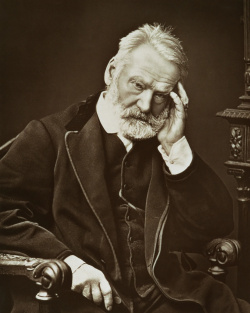Victor Hugo
Victor Hugo was a noteworthy writer (1802-1885). Hugo is famous for the works he wrote, including The Hunchback of Notre Dame and Les Misérables. Although he has yet to appear in Gargoyles, his works have been referenced in the series.
Contents
Real World Background
In addition to his works of literature, Hugo was also a politician. Initially a supporter of the monarchy, he later favored republicanism but over time became disillusioned with whoever was in power. He would live in exile for nearly thirty years due his criticisms of France's various governments. Throughout his life, Hugo publicly advocated for universal suffrage, free education for children, and the abolition of capital punishment and slavery. [1]
In an 1864 work dedicated to William Shakespeare, Hugo referred to the Bard as "L'Homme Océan" ("the Ocean Man"), comparing the feat of trying to fathom the Bard's genius to that of observing the ocean. The nickname would be applied to Hugo himself later in his lifetime.
Hugolian allusions in Gargoyles
Greg Weisman has shared his enthusiasm for Victor Hugo and the influence its had on the show. [2]
- "Sanctuary" - At Notre Dame Cathedral, Goliath refers to Thailog as the "Notre Dame monster". Later in the episode, Thailog refers to himself as "the monster of Notre Dame".
- "Losers" - The Director shares a call with a Monsieur Le Maire, a name used by Jean Valjean in Les Misérables.
- "Quo Vadis Cum Hoc?" - Monsieur Le Maire makes his proper debut, with Shahrizad referring to him as "Jean", further connecting him to his "Jean Valjean" persona.
Apocrypha
Disney Adventures
"The Experts" - The story starts with Elisa and the Trio having finished viewing Disney's Hunchback of Notre Dame film. All four of them enjoyed it, though the Trio poke fun at the depiction of gargoyles.
See Also
- Victor Hugo at Wikipedia, the Free Encyclopedia
